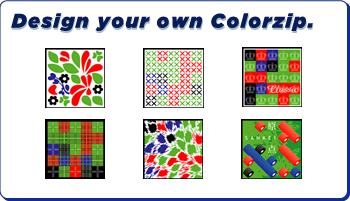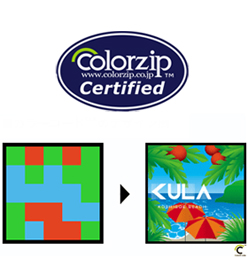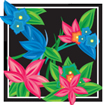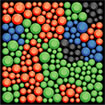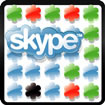 Normal PM Code with data memory capability uses 8-24 colors. Memory ranges from about 0.6MB~1.8MB (4,083,264 figures). Image Credit: C.I.A.
Normal PM Code with data memory capability uses 8-24 colors. Memory ranges from about 0.6MB~1.8MB (4,083,264 figures). Image Credit: C.I.A.QR Based PM Code - The Best 3D Symbology Ever, Really!
And it is a 5th Generation Media symbology known as the PM Code. With this printed symbology one can use a simple cellphone with a camera and unleash incredible variants of communication ranging from simple data, to sound, to video … all at the snap of a camera button on the phone.
In the worlds of automatic identification and information technology, the question of what is the best machine-readable information-packed symbology ever has been answered ... Again!
Why?
Well, until someone comes up with a device readable code that can hold about 1.236 GB of information (2,854,408,421,376 figures) - Deliver as much information from a printed media symbology (code) to have a phone with the corresponding decode program and a camera play a low-resolution video with sound for approximately 20 seconds, or have the phone reach out automatically to entertainer, advertiser, and manufacturer websites to retrieve additional database stored information via Internet Protocol … then one can dispute this claim!!!
 IP (Internet Protocol) based PM Code uses 256 colors. Memory ranges to about 1,236GB (2,854,408,421,376 figures). Image Credit: C.I.A.
IP (Internet Protocol) based PM Code uses 256 colors. Memory ranges to about 1,236GB (2,854,408,421,376 figures). Image Credit: C.I.A.The best symbology ever?
The best symbology ever may well be the PM Code (PM = Paper Memory), developed by a relatively new Japanese start-up company known as Content Idea of Asia Co., Ltd. (C.I.A.), The algorithm basis comes from the DENSO Wave - developed QR Code – originally intended for use in tracking and aiding the complex task of automobile parts manufacturing and sourcing throughout the automobile assembly process.
 CL Code with data memory capability. Memory ranges from about 72KB (170,136 figures). Image Credit: C.I.A.
CL Code with data memory capability. Memory ranges from about 72KB (170,136 figures). Image Credit: C.I.A.C.I.A. also has developed a “sister” code known as the CL Code (CL = Clear Code) which describes the effect of being able to add a code that does not need to be dark contrast against a light background to be decoded. This allows the information reference code to be laid on top of media in a transparent, layered look - in order to not take away from the printed media onto which it is applied.
 Simple CL Code application in tomato photo. Image Credit: C.I.A.
Simple CL Code application in tomato photo. Image Credit: C.I.A.The advantages of using the CL Code is that the customer’s viewing of marketing designs and images will not be hampered due to the application of an identifying Physical World Hyperlink or Physical World Identifier/Connection for the customer to use when getting additional information. One technique suggests that the CL Code may be printed in a band of matching product colored ink on the bottle. The information would not be able to be decoded until the contents of the bottle have been consumed or poured out … thus leaving the CL Code in a readable format.
Content Idea of Asia Co., Ltd. Explains the concept this way. Both the CL Code and its more robust “sister” PM Code are examples of 5th Generation Media.
What does this "5th Generation Media mean? Well,
1st Generation Media refers to paper media such as magazines, newspapers, and other printed media stratum.
2nd Generation Media refers to audio radio communication.
3rd Generation Media refers to television, video, and film media communications.
4th Generation Media refers to Information Technologies (IT) found in the digital world of computers and cellular telephones.
So now we come full circle and fuse the previous forms of communication together.
5th Generation Media allows the fusion of all forms of media to interact and cooperate, in order to take the advantage of each form to deliver a more effective level of communication through the application of this unique database found in a 3D (three-dimensional) color QR based code. A simple cellphone with a camera can unleash incredible variants of communication ranging from simple data, to sound, to video - YES VIDEO! … all at the snap of a camera button on the phone.
 No IP address – just the PM Code and the “old media” adverts come to life! Applications include listening to portions of songs, videos, short how-to-use vignettes, security for access control, save, re-write, and store data media on flat format paper (instead of CD’s, DVD’s, or HD discs), and well, the sky is the limit.
No IP address – just the PM Code and the “old media” adverts come to life! Applications include listening to portions of songs, videos, short how-to-use vignettes, security for access control, save, re-write, and store data media on flat format paper (instead of CD’s, DVD’s, or HD discs), and well, the sky is the limit.
Hey, how’s this - you are a curator of a museum and you would like the patrons to enjoy the exhibit a little more deeply with sound descriptions of what they are seeing. Place PM Codes next to each display and voila, the patron can hear all they wanted to know about the painting and the painter - complete with a video snippet on the painter’s technique. All of this interactive information without involving the audio/visual department and/or the equipment investment.
Next up?
The addition of smell - Okay, so this may be a little overboard ... but you get the idea!
HT: Content Idea of ASIA co., Ltd.
